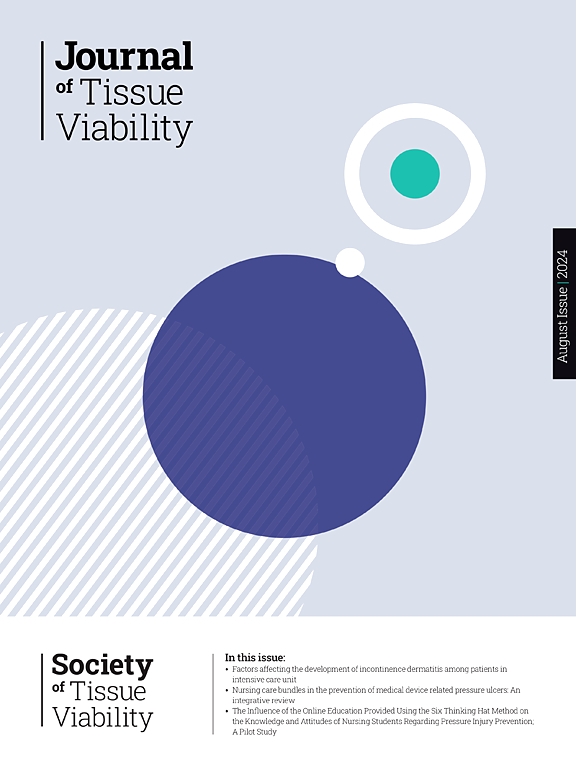Exploring physiological differences in injury response by skin tone: A scoping review
IF 2.4
3区 医学
Q2 DERMATOLOGY
引用次数: 0
Abstract
Aim
To explore existing literature examining physiological differences in pressure ulcer response among individuals with differing skin tones.
Methods
This was a scoping review. Articles meeting the inclusion criteria were retrieved from electronic databases including PubMed, CINAHL, Scopus, Cochrane, and EMBASE, using the keywords "pressure ulcer," "skin pigmentation," "melanin," and "risk factor." Data were extracted using a predesigned data extraction tool and analysed using a narrative synthesis.
Results
Five papers met the inclusion criteria. Analysis of findings suggests there are potential mechanisms which may influence the skin's ability to withstand mechanical stress and its inflammatory response to damage among those with different skin tones; the structure of the stratum corneum, collagen density, fibroblast activity, mast cell density, and transepidermal water loss (TEWL). The stratum corneum can compromise skin resilience, while collagen density and fibroblast activity may impact skin strength and repair. Mast cells affect inflammation, which can exacerbate pressure ulcer damage, and increased TEWL in those with dark skin tones can result in lower water content in the stratum corneum, affecting hydration.Conversely, factors like melanosome size, hair follicle and hair fiber characteristics, sebaceous gland activity, vitamin D production, UVR protection, and desquamation rate, although relevant to overall skin health, may not directly affect the mechanical processes leading to pressure ulcer formation.
Conclusions
Physiological differences in skin structure may contribute to alterations in the response to pressure ulcer development among individuals with dark skin. Recognising these differences is important for targeted prevention strategies within diverse populations. However, further research is needed to explore the mechanisms underlying this association in greater detail.
肤色对损伤反应生理差异的研究综述
目的探讨研究不同肤色人群对压疮反应的生理差异的现有文献。使用关键词 "压疮"、"皮肤色素沉着"、"黑色素 "和 "风险因素",从 PubMed、CINAHL、Scopus、Cochrane 和 EMBASE 等电子数据库中检索符合纳入标准的文章。采用预先设计的数据提取工具提取数据,并采用叙事综合法对数据进行分析。分析结果表明,有一些潜在机制可能会影响不同肤色人群的皮肤承受机械压力的能力及其对损伤的炎症反应;这些机制包括角质层结构、胶原蛋白密度、成纤维细胞活性、肥大细胞密度和经表皮失水(TEWL)。角质层会损害皮肤的韧性,而胶原蛋白密度和成纤维细胞活性则会影响皮肤的强度和修复。肥大细胞会影响炎症,从而加剧褥疮的损伤,肤色深的人 TEWL 增加会导致角质层含水量降低,影响水合作用。相反,黑色素体大小、毛囊和毛发纤维特征、皮脂腺活动、维生素 D 生成、紫外线防护和脱屑率等因素虽然与整体皮肤健康有关,但可能不会直接影响导致压疮形成的机械过程。认识到这些差异对于在不同人群中采取有针对性的预防策略非常重要。然而,要更详细地探索这种关联的内在机制,还需要进一步的研究。
本文章由计算机程序翻译,如有差异,请以英文原文为准。
求助全文
约1分钟内获得全文
求助全文
来源期刊

Journal of tissue viability
DERMATOLOGY-NURSING
CiteScore
3.80
自引率
16.00%
发文量
110
审稿时长
>12 weeks
期刊介绍:
The Journal of Tissue Viability is the official publication of the Tissue Viability Society and is a quarterly journal concerned with all aspects of the occurrence and treatment of wounds, ulcers and pressure sores including patient care, pain, nutrition, wound healing, research, prevention, mobility, social problems and management.
The Journal particularly encourages papers covering skin and skin wounds but will consider articles that discuss injury in any tissue. Articles that stress the multi-professional nature of tissue viability are especially welcome. We seek to encourage new authors as well as well-established contributors to the field - one aim of the journal is to enable all participants in tissue viability to share information with colleagues.
 求助内容:
求助内容: 应助结果提醒方式:
应助结果提醒方式:


